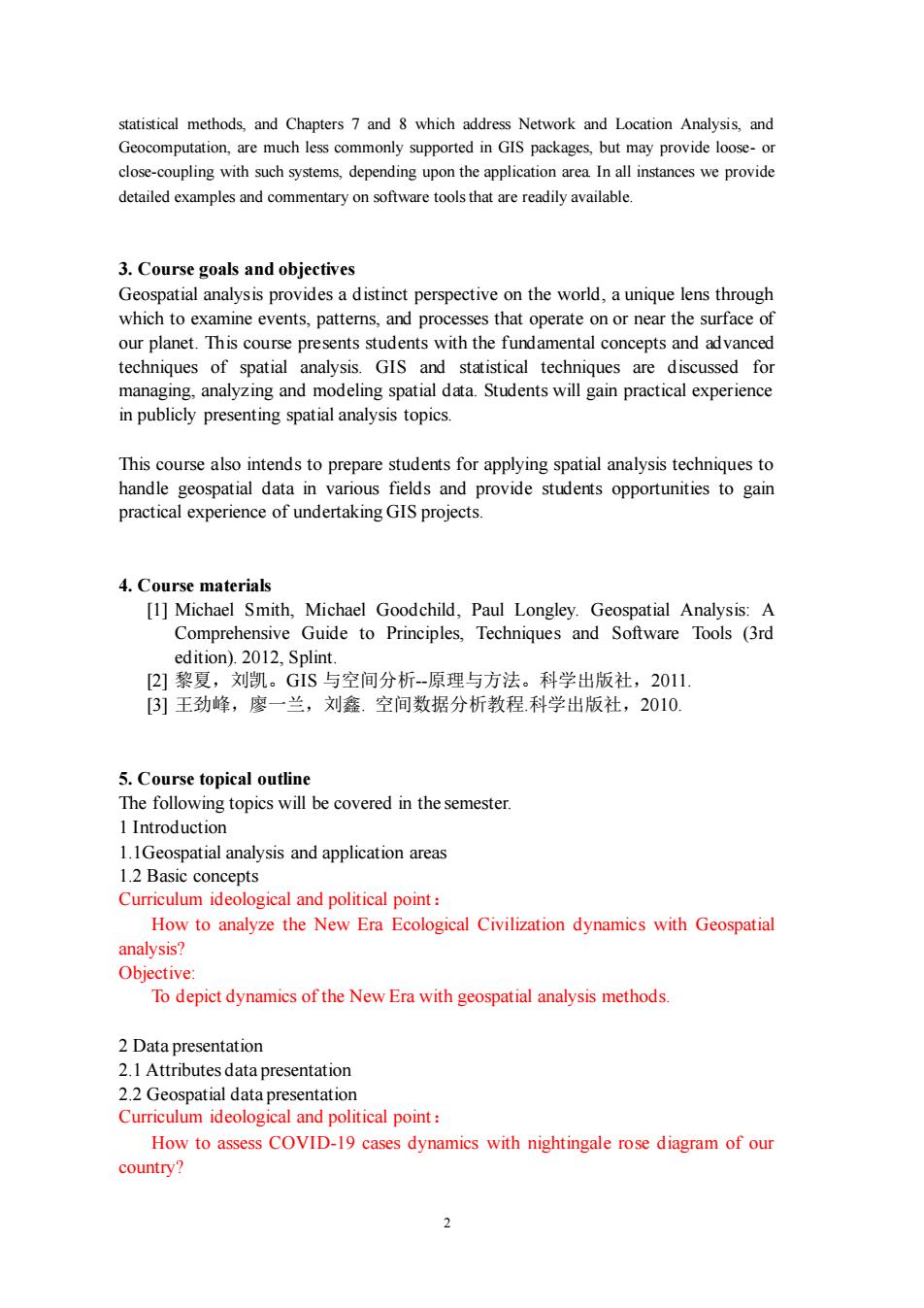正在加载图片...

statistical methods.and Chapters 7 and 8 which address Network and Location Analysis.and Geocomputation,are much less commonly supported in GIS packages,but may provide loose-or instances we provide detailed examples and commentary on software tools that are readily available. 3.Course goals and objectives spatial analysis n which to examine events,patterns,and processes that operate on or near the surface of our planet.This course presents students with the fundamental concepts and advanced techniques of spatial analysis.GIS and statistical techniques are discussed for managing.analyzing and modeling spatial data.Students will gain practical experience in publicly presenting spatial analysis topics This course also intends to prepare students for applying spatial analysis techniques to handle geospatial data in various fields and provide students opportunities to gain practical experience of undertaking GIS projects. 4.Course materials [1]Michael Smith,Michael Goodchild,Paul Longley.Geospatial Analysis:A Comprehensive Guide to Principles,Techniques and Software Tools (3rd edition)2012 Splint 21黎夏,刘凯。GIS与空间分析-原理与方法。科学出版社,2011 [3]王劲峰,廖一兰,刘鑫 空间数据分析教程.科学出版社,2010 5.Course topical outline The following topics will be covered in the semester 1Introduction 1.1Geospatial analysis and application areas 1.2 Basic concepts Curriculum ideological and political point: How to analyze the New Era Ecological Civilization dynamics with Geospatial analysis? Objective: To depict dynamics of the New Era with geospatial analysis methods. 2 Datapresentation Curriculum ideological and political point: How to assess COVID-19 cases dynamics with nightingale rose diagram of our country? 22 statistical methods, and Chapters 7 and 8 which address Network and Location Analysis, and Geocomputation, are much less commonly supported in GIS packages, but may provide loose- or close-coupling with such systems, depending upon the application area. In all instances we provide detailed examples and commentary on software tools that are readily available. 3. Course goals and objectives Geospatial analysis provides a distinct perspective on the world, a unique lens through which to examine events, patterns, and processes that operate on or near the surface of our planet. This course presents students with the fundamental concepts and advanced techniques of spatial analysis. GIS and statistical techniques are discussed for managing, analyzing and modeling spatial data. Students will gain practical experience in publicly presenting spatial analysis topics. This course also intends to prepare students for applying spatial analysis techniques to handle geospatial data in various fields and provide students opportunities to gain practical experience of undertaking GIS projects. 4. Course materials [1] Michael Smith, Michael Goodchild, Paul Longley. Geospatial Analysis: A Comprehensive Guide to Principles, Techniques and Software Tools (3rd edition). 2012, Splint. [2] 黎夏,刘凯。GIS 与空间分析--原理与方法。科学出版社,2011. [3] 王劲峰,廖一兰,刘鑫. 空间数据分析教程.科学出版社,2010. 5. Course topical outline The following topics will be covered in the semester. 1 Introduction 1.1Geospatial analysis and application areas 1.2 Basic concepts Curriculum ideological and political point: How to analyze the New Era Ecological Civilization dynamics with Geospatial analysis? Objective: To depict dynamics of the New Era with geospatial analysis methods. 2 Data presentation 2.1 Attributes data presentation 2.2 Geospatial data presentation Curriculum ideological and political point: How to assess COVID-19 cases dynamics with nightingale rose diagram of our country?